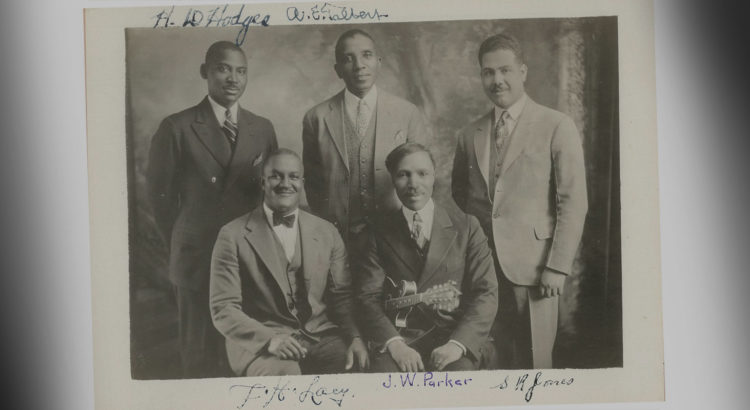In Ian’s mother’s youth, and in his own teenage years, autograph albums were popular – asking friends and relations to contribute a page with a drawing, poem, personal message or other memento. When Ian was asked to contribute to a friend’s album, he often reproduced the first entry in his own album: ‘It’s not the gale, but the set of the sail, which tells us the way to go.’ Ian discovered, with incredulity, when compiling this note at the age of 87, that the author of that couplet, Ella Wheeler Wilcox, was also the author of the poem, The Valley of Fear, which is the fifth entry here from Isobel Ingram’s album.
Ten pages are copied here from her album, from 1913 (when she was 17) to 1920:
- Five about life during the Great War, 1914 to 1918, and
- Five, chronologically from 1913 to 1920, by evangelists and Bible teachers.
Simply click on the thumbnail images to enlarge
LIFE AND DEATH DURING WORLD WAR ONE
1. Bert Shaw, Gallipoli
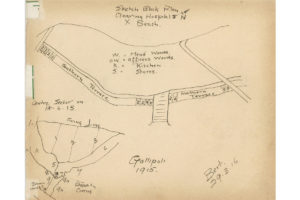 On 29 March 1916, Isobel’s cousin, Robert Shaw (Bert), sketched the Clearing Hospital at Gallipoli as he knew it in 1915. In what capacity he was there is not now known, but his later career was in electrical engineering. There is a photograph of him in the ‘Family Tree of Ian’s mother’ on this website – photo 17, at the right of the chart.
On 29 March 1916, Isobel’s cousin, Robert Shaw (Bert), sketched the Clearing Hospital at Gallipoli as he knew it in 1915. In what capacity he was there is not now known, but his later career was in electrical engineering. There is a photograph of him in the ‘Family Tree of Ian’s mother’ on this website – photo 17, at the right of the chart.
In the Gallipoli Campaign, from February 1915 to January 1916, Britain, France and Russia tried to take control, from the Ottoman Empire, of the Dardanelle straits that provided a supply route to Russia. The invaders launched a naval attack followed by an amphibious landing. The naval attack was repelled and after eight months’ fighting, with many casualties on both sides, the land campaign was abandoned and the invasion force was withdrawn.
2. Isobel’s contribution to the war-effort
Isobel volunteered to cook at a military hospital at Kingsknowe, Edinburgh. It was a full-time, live-in appointment, and as the last line of the poem that follows puts it: ‘She works from morn till night’. She learned tips from the professional chefs that she put to good use for the rest of her life. One of the family wrote in Isobel’s autograph album:
‘Twas a dark and dreary day,
When our darling went away,
To join the band of Voluntary Aiders,
Our hearts were filled with pain,
As she puffed off in the train,
She did not know how wretched she had made us.
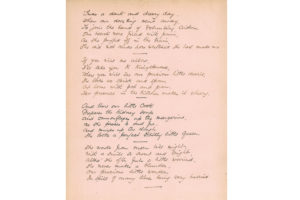 If you will me allow,
If you will me allow,
I’ll take you to Kingsknowe,
Where you will see our precious little dearie,
She looks so spick and span,
At home with pot and pan,
Her presence in the kitchen makes it cheery,
And now our little Cook,
Prepares the Kidney soup,
And camouflages up the margarine,
As she passes to and fro,
And mixes up the dough,
She looks a perfect stately little queen.
She works from morn till night,
With a smile so sweet and bright,
Although she often feels a little worried,
She never makes a blunder,
Our precious little wonder,
In spite of many times being very hurried.
3. Contribution by D. Robertson in 1915
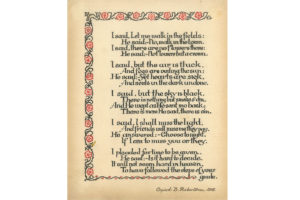 Included here because of the beautiful script. These are the first five verses of a seven-verse poem, later set to music as a hymn; neither the author nor the musician was called Robertson, so the writing must be by a friend of that name. As the wording is clear on the scan from the album, the words are not reproduced here.
Included here because of the beautiful script. These are the first five verses of a seven-verse poem, later set to music as a hymn; neither the author nor the musician was called Robertson, so the writing must be by a friend of that name. As the wording is clear on the scan from the album, the words are not reproduced here.
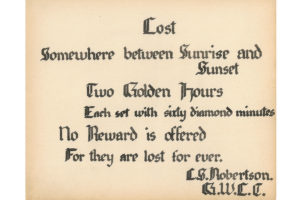 4. Exhortation from Horace Mann
4. Exhortation from Horace Mann
Contributed to the album by L. S. Robertson. The significance of ‘G.W.L.C.’ is not now known, but the page is included here because of the beautiful script. As the wording is clear on the scan from the album, the words are not reproduced here.
5. The Valley of Fear
A 1916 poem, The Valley of Fear, by an American author and poet, Ella Wheeler Wilcox, is transcribed in full on the front and back of a page in the album. The contributor’s name is not there, but Isobel wrote, in the top right-hand corner, ‘Written a few hours before leaving for France. Died of wounds, 19th April 1917.’
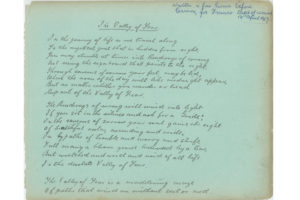 In the journey of life, as we travel along
In the journey of life, as we travel along
To the mystical goal that is hidden from sight,
You may stumble at times into Roadways of Wrong,
Not seeing the sign-board that points to the right.
Through caverns of sorrow your feet may be led,
Where the noon of the day will like midnight appear.
But no matter whither you wander or tread,
Keep out of the Valley of Fear.
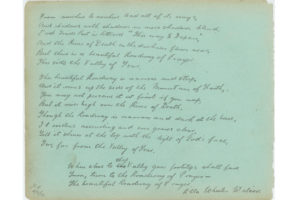 The Roadways of Wrong will wind out into light
The Roadways of Wrong will wind out into light
If you sit in the silence and ask for a Guide;
In the caverns of sorrow your soul gains its sight
Of beautiful vistas, ascending and wide.
In by-paths of worry and trouble and strife
Full many a bloom grows bedewed by a tear,
But wretched and arid and void of all life
Is the desolate Valley of Fear.
The Valley of Fear is a maddening maze
Of paths that wind on without exit or end,
From nowhere to nowhere lead all of its ways,
And shadows with shadows in more shadows blend.
Each guide-post is lettered, ‘This way to Despair,
‘
And the River of Death in the darkness flows near,
But there is a beautiful Roadway of Prayer
This side of the Valley of Fear.
This beautiful Roadway is narrow and steep,
And it runs up the side of the Mountain of Faith.
You may not perceive it at first if you weep,
But it rises high over the River of Death.
Though the Roadway is narrow and dark at the base,
It widens ascending and ever grows clear,
Till it shines at the top of the Light of God’s face,
Far, far from the Valley of Fear.
When close to that Valley your footsteps shall fare,
Turn, turn to the Roadway of Prayer –
The beautiful Roadway of Prayer.
EVANGELISTS AND BIBLE TEACHERS
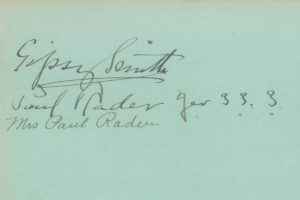 6. ‘Gipsy’ Rodney Smith
6. ‘Gipsy’ Rodney Smith
Gipsy Smith, then aged 53, conducted a mission in the Assembly Hall on the Mound in Edinburgh from Sunday 2 to Wednesday 12 March 1913. Thousands flocked to hear him. Details of the mission are on this website under ‘Citywide Edinburgh Missions’.
Paul Radar was an American evangelist, aged 34 in 1913, who also wrote hymns, so presumably he and his wife were with Gipsy Smith in some supporting role – their signatures are directly below Smith’s. The Biblical reference is in his writing – Jeremiah 33:3.
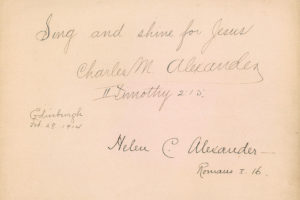 7. Charles and Helen Alexander
7. Charles and Helen Alexander
Charles (Charlie) Alexander, an American then aged 47, was the soloist at John Wilbur Chapman’s mission in the Olympia Palace Picture House (Cinema), in Annandale Street, off Leith Walk, from 4 February to 4 March 1914. (A huge redbrick garage for Lothian Buses now occupies the site.) He ‘warmed up’ the audience with jovial humour and lively singing. Some churches continued to use Alexander’s Hymnbook No. 3, which had been the mission songbook, at their evening (evangelistic) services for many years. He and his wife signed Isobel’s album on 28 February 1914. The texts which the gave were 2 Timothy 2:15 and Romans 1:16. Details of the mission are on this website under ‘Citywide Edinburgh Missions’.
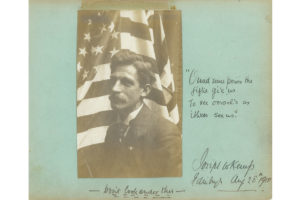 8. Joseph Kemp
8. Joseph Kemp
Joseph Kemp was the minister of Charlotte Baptist Chapel, Edinburgh, from 1902 to 1915. This autograph is dated 28 August 1914. Isobel’s father was an active member of the Newhaven Parish Church, and its Sunday School Superintendent, but he walked his family (literally, not believing in using public transport on Sundays) to Charlotte Chapel for the Sundays evening service because of its evangelistic nature.
The quotation beside the photograph is from Robert Burns: ‘O wad some power the giftie gi’e us, To see oorsel’s as ithers see us.’ Underneath the photograph – Don’t look under this – ‘ is a sketch (not copied here) of a friend and the words ‘A friend is one who knows all about you and loves you just the same.’ Proverbs 18:24.
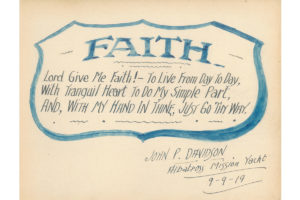 9. Albatross Mission Yacht
9. Albatross Mission Yacht
The Albatross Mission Yacht was just that – a large private steam yacht, manned by a group of young people, who sailed from resort to resort, mostly on the west coast of Scotland, holding evangelistic meetings at their ports of call. One evangelist, Neil McIntye, not the John Davidson who gave this autograph, was with the yacht for twelve years. Whether the yacht docked in Leith in September 1919, or whether Isobel met John Davidson on the west coast, is not known. As the wording is clear on the scan from the album, the words are not reproduced here.
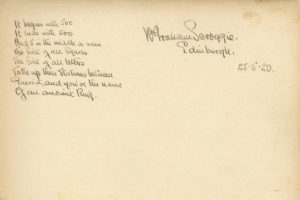 10. Graham Scroggie
10. Graham Scroggie
Graham Scroggie was the minister of Charlotte Baptist Chapel, Edinburgh, from 1916 to 1933. For Isobel’s attendance at Charlotte Chapel, see the explanation in the previous section. Scroggie wrote on 25 May 1920:
It begins with 500
It ends with 500
And 5 in the middle is seen
The first of all figures
The first of all letters
Take up their stations between
Guess it, and you’ve the name
Of an ancient King.
W. Graham Scroggie
Edinburgh, 25.5.20
(The answer to Scroggie’s puzzle is ‘David’)
